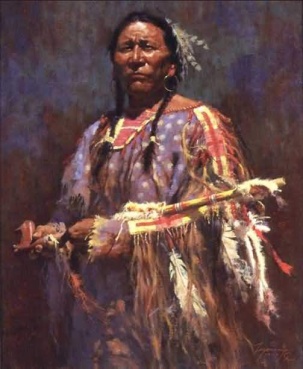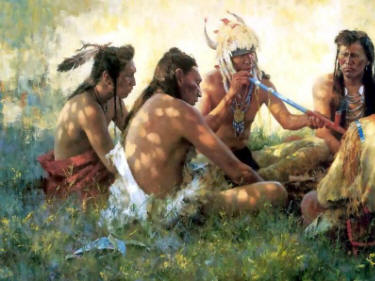The pipe ceremony is a sacred ritual for connecting physical and spiritual worlds. "The pipe is a link between the earth and the sky," explains White Deer of Autumn. "Nothing is more sacred. The pipe is our prayers in physical form. Smoke becomes our words; it goes out, touches everything, and becomes a part of all there is. The fire in the pipe is the same fire in the sun, which is the source of life." The reason why tobacco is used to connect the worlds is that the plant's roots go deep into the earth, and its smoke rises high into the heavens.

There are different kinds of pipes and different uses for them. There are personal pipes and family pipes as well as pipes for large ceremonies. The particular stone used depends upon the tribe's location, and various symbols are added to attract certain spiritual energies. Also, the type of tobacco used depends on tribal custom in the pipe ceremony. But despite these differences, there are certain important similarities: The pipe ceremony invokes a relationship with the energies of the universe, and ultimately the Creator, and the bond made between earthly and spiritual realms is not to be broken.
Ed McGaa (Eagle Man), an Ogalala Sioux, and author of Mother Earth Spirituality: Native American Paths to Healing Ourselves and Our World, says that most pipe ceremonies have the same intention: to call upon and thank the six energies: "All of our Sioux ceremonies beseech to the four directions, the earth and sky, and ultimately the Great Spirit. We see our Creator through nature, and we try to emulate what the Creator has made. This has worked out well, as you can see from the track record of Native American people. The old time Indians were honest, ethical people, and they had an unblemished environmental record. When the Pilgrims first landed, they kept them alive, and they took in black slaves. They were extremely humanistic. That's one of the main reasons that I believe in the natural way."
Eagle Man begins a pipe ceremony by beseeching the West power, while thinking about the life giving rains and the ever present spirit world. Next, he beseeches the north power, the source of endurance, strength, truthfulness, and honesty, which are qualities needed to walk down a good path in life. Then, he will look to the east power. The east is where the sun rises, and the sun brings us knowledge, the essence of spirituality such as meditation practices. Without knowledge, we become ignorant and cause harm to ourselves and others. The fourth energy is the south power, which brings us bounty, medicine, and growth. Next to be acknowledged is the earth spirit. Eagle Man touches the pipe to the ground, and says, "Mother Earth, I seek to protect you." Since Mother Earth depends on the sun's life giving energy, the pipe is then held up towards the sky. Lastly, the pipe is held straight up to the Great Spirit, the Great Mystery, the unexplainable source of all life. These words are then spoken: "Oh Great Spirit, I thank you for the six powers of the universe." Unlike many westerners, Eagle Man explains that the person reaching out to the spirit world has no fear: "Most of us are not afraid of the Great Spirit. We don't fear something that has given us our life."

Legal names are given, but Native American names are earned. Gabriel Horn gives a personal account of why and how his Indian name was chosen: "By the time I graduated from college, I had already done my battles for the people. I had protested against stereotypes of Native Americans, I had fought for a Native American literature course on campus, and I had asked for participation in the United Nations. My immediate family believed that I had earned a name. The name came to my uncle, a traditional Cherokee man, who had a vision of a white deer coming to him and singing my name. He knew it was to be White Deer.
"My godmother, my uncle, and some close friends attended the Native American names ceremony. A pipe was filled with tobacco, and offered to each direction, as they called out my name. They called it out to the east, the south, the west, and the north. They called it out to the sky and to the earth. They called it out to the plants. They called it out to the animals. In other words, I was introduced to the universe as White Deer. That was my rebirth. In a sense, I was a born again Indian at that point." Receiving a new name was a healing experience. I was now completely comfortable with my Indian identity, whereas before I felt fragmented, not totally in touch with who I was."
Name changes can be physically as well as psychologically healing. Some time later, White Deer became ill, and a longer name was the solution: "I had gotten very sick, and was near death. A very old Ojibwa medicine man from Canada came down to Minnesota. I believe he was over 100 years old, and he didn't speak any English. During the ceremony of healing for me, a manifestation appeared in the room. At that point, the medicine man said that the entity wanted me to also be called Autumn. I was now White Deer of Autumn. The ceremony ended, and my sickness was healed.
"The name, of course, bestows certain powers and responsibilities. The power of the deer is its awareness, its keenness, and its protective nature. The white is purity, purity of heart, mind, and words. Autumn, I was told, is a time when change is most visible. It's a time when change is at its most powerful. And so, I was named for that season."
Native American names can be passed down, as western names often are. The distinction is that you are not stuck with one name all your life. This represents different beliefs about human potential, says White Deer of Autumn: "Crazy Horse passed on his name to his son, who took the name Worm as he got older. So, we can pass on names, too. The idea is that you're not stuck with the name you were given at birth. In western society, it's almost as if you can't change; you can't evolve; you can't grow. From a native perspective, your name reflects who you are. White Deer of Autumn reflects what I've done. But as I go on in life, I may want to let go of that and take another name. I have that right. So, naming is the ability to evolve and change in your identity. I think this is healing, both physically and emotionally."
| |
Native American Chanunpa Sacred Pipe Ceremony |
![]()


